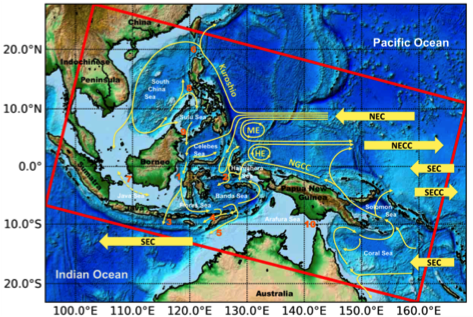Assessing the impact of changing temperature and circulation on coral connectivity in the Coral Triangle
The Coral Triangle (CT) is a global center of marine biodiversity [Carpenter et al., 2011] and supports the livelihoods of millions of people. Unfortunately, it is also considered the most threatened of all reef regions, with rising temperature and coral bleaching already taking a toll [Oliver et al., 2009]. Reproductive connectivity between reefs plays a critical role in the reef’s capacity to recover after such disturbances [Fernandes et al., 2012]. However, our understanding of the degree of connectivity between reefs is limited by the paucity of observations. Thus, oceanographic modeling efforts to understand patterns of reef connectivity [e.g., Wood et al. 2014] are essential to the effective design of a network of Marine Protected Areas (MPAs) to conserve marine ecosystems in this region [McLeod et al., 2010; Ministry of Marine Affairs and Fisheries, 2008].

This project utilizes a Regional Ocean Modeling System developed for the Coral Triangle (CT-ROMS) and a Lagrangian particle tracking tool (TRACMASS, [Döös 2012]) to investigate the probability of coral larval transport between reefs in this region (“potential connectivity,” [Watson et al. 2010]). Using a 46-year climate simulation, this study was the first high resolution analysis of potential connectivity in the CT region, its variability through time over the historical period, and the change in connectivity under future anthropogenic warming [Thompson et al., 2014; Thompson et al., in prep].
Additional biological constraints also play an important role in modulating larval connectivity and connectivity variability. The next step of this ongoing work will combine potential connectivity with biological factors such as reproductive output (adult abundance and fecundity), larval mortality and competency to settle (i.e. pelagic larval duration and precompetency period) to assess patterns of “realized connectivity.” We will include the effects of temperature on the biological factors that impact realized connectivity for three species representing competitive (A. millepora), weedy (P. damicornis), and stress-tolerant (P. lobata) life history strategies. We will also investigate the impact of future warming on these biological factors and the resulting connectivity patterns. These simulations and resulting patterns of realized connectivity will be used to address key remaining questions:
- How does rising temperature affect the biological factors driving realized connectivity?
- Which biological factor will be most limiting to dispersal under future climate?
- How does realized connectivity vary seasonally and interannually for broadcast spawning and brooding corals? How does this relate to climate and what serves as the ultimate cue for coral spawning in this region?
- How does realized connectivity vary between these different life history strategies? Which life history strategies are favored under future warming scenarios?
Collaborators
- Dr. Frederic Castruccio, National Center for Atmospheric Research
- Dr. Enrique Curchitser, Rutgers University
- Dr. Liz Drenkard, Rutgers University
- Dr. Raphael Dussin, Rutgers University
- Dr. Joan Kleypas, National Center for Atmospheric Research
- Dr. M. L. Pinsky, Rutgers University
-
Lisa C. McManus
 , PhD candidate, Princeton University
, PhD candidate, Princeton University
- Dr. James Watson, Oregon State University